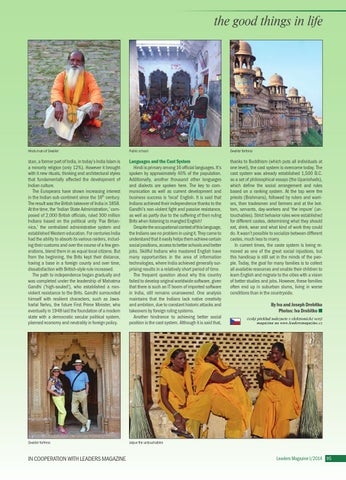the good things in life
Hindu man of Gwalior
Public school
Gwalior fortress
stan, a former part of India, in today’s India Islam is a minority religion (only 12%). However it brought with it new rituals, thinking and architectural styles that fundamentally affected the development of Indian culture. The Europeans have shown increasing interest in the Indian sub-continent since the 16th century. The result was the British takeover of India in 1858. At the time, the ‘Indian State Administration,’ composed of 2,000 British officials, ruled 300 million Indians based on the political unity ‘Pax Britannica,’ the centralized administrative system and established Western education. For centuries India had the ability to absorb its various raiders, including their customs and over the course of a few generations, blend them in as equal local citizens. But from the beginning, the Brits kept their distance, having a base in a foreign county and over time, dissatisfaction with British-style rule increased. The path to independence began gradually and was completed under the leadership of Mahatma Gandhi (‘high-souled’), who established a nonviolent resistance to the Brits. Gandhi surrounded himself with resilient characters, such as Jawaharlal Nehru, the future First Prime Minister, who eventually in 1948 laid the foundation of a modern state with a democratic secular political system, planned economy and neutrality in foreign policy.
Languages and the Cast System Hindi is primary among 16 official languages. It’s spoken by approximately 40% of the population. Additionally, another thousand other languages and dialects are spoken here. The key to communication as well as current development and business success is ‘local’ English. It is said that Indians achieved their independence thanks to the Gandhi’s non-violent fight and passive resistance, as well as partly due to the suffering of then ruling Brits when listening to mangled English! Despite the occupational context of this language, the Indians see no problem in using it. They came to understand that it easily helps them achieve certain social positions, access to better schools and better jobs. Skillful Indians who mastered English have many opportunities in the area of information technologies, where India achieved generally surprising results in a relatively short period of time. The frequent question about why this country failed to develop original worldwide software, given that there is such an IT boom of imported software in India, still remains unanswered. One analysis maintains that the Indians lack native creativity and ambition, due to constant historic attacks and takeovers by foreign ruling systems. Another hindrance to achieving better social position is the cast system. Although it is said that,
thanks to Buddhism (which puts all individuals at one level), the cast system is overcome today. The cast system was already established 1,500 B.C. as a set of philosophical essays (the Upanishads), which define the social arrangement and rules based on a ranking system. At the top were the priests (Brahmans), followed by rulers and warriors, then tradesmen and farmers and at the bottom, servants, day-workers and ‘the impure’ (untouchables). Strict behavior rules were established for different castes, determining what they should eat, drink, wear and what kind of work they could do. It wasn’t possible to socialize between different castes, much less to marry. In current times, the caste system is being removed as one of the great social injustices, but this handicap is still set in the minds of the people. Today, the goal for many families is to collect all available resources and enable their children to learn English and migrate to the cities with a vision of better studies and jobs. However, these families often end up in suburban slums, living in worse conditions than in the countryside.
Gwalior fortress
Jaipur the untouchables
IN COOPERATION WITH LEADERS MAGAZINE
By Iva and Joseph Drebitko Photos: Iva Drebitko ■ český překlad naleznete v elektronické verzi magazínu na www.leadersmagazine.cz
Leaders Magazine I/2014 95
